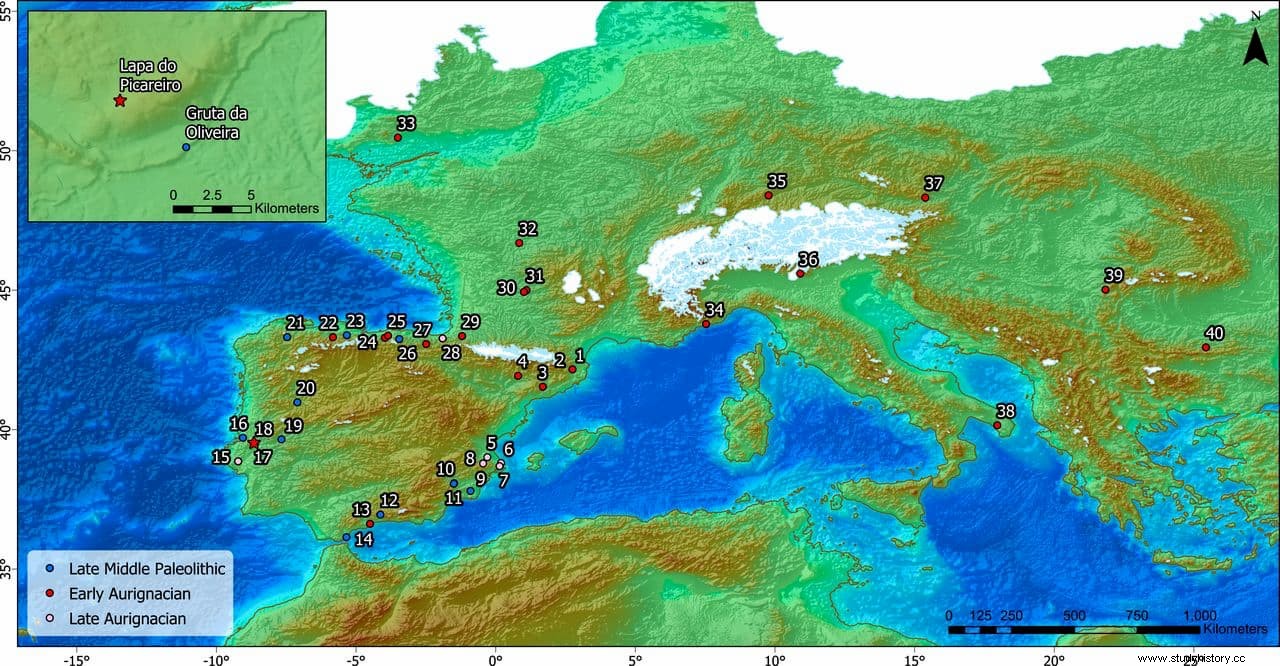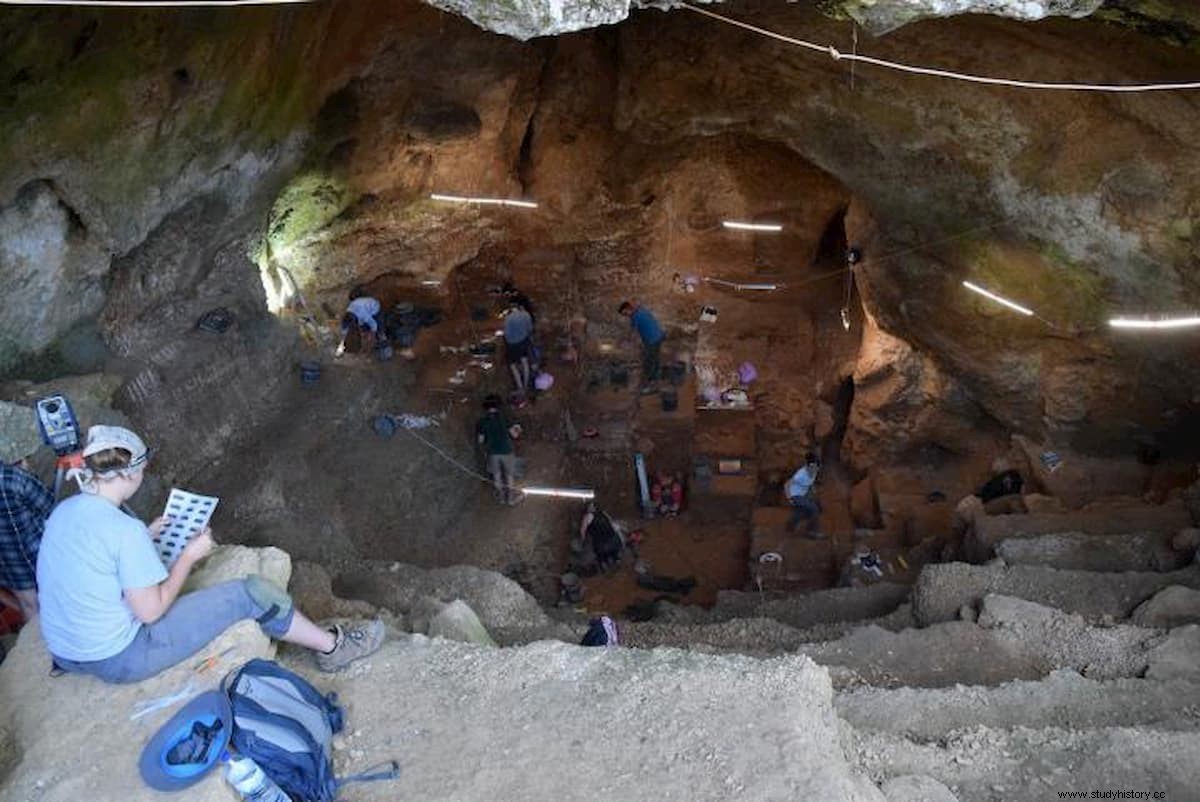Modern humans arrived in the westernmost part of Europe between 41,000 and 38,000 years ago, about 5,000 years earlier than previously thought, according to Dr. Jonathan Haws, of the Department of Anthropology at the University of Louisville, and an international team of researchers. researchers. The team has revealed the discovery of stone tools used by modern humans dating to an earlier time period, in a paper published in the Proceedings of the National Academy of Sciences journal. .
The tools, discovered in a cave called Lapa do Picareiro, located near the Atlantic coast of central Portugal, link the site to similar finds stretching from Eurasia to the Russian plains. The discovery supports a rapid westward dispersal of modern humans across Eurasia, only a few thousand years from their first appearance in southeastern Europe. The instruments document the presence of modern humans in Western Europe at a time when Neanderthals were thought to be present in the area. The finding has important ramifications for understanding the possible interaction between the two human groups and the definitive disappearance of the Neanderthals.

The question of whether the last surviving Neanderthals in Europe were replaced or assimilated by modern humans is still an unresolved debate in paleoanthropology said Lukas Friedl, an anthropologist at the University of West Bohemia in Pilsen, Czech Republic, and co-director of the project. The earliest dates for Aurignacian stone tools at Picareiro probably rule out the possibility that modern humans arrived in a land where Neanderthals had long since disappeared, and that in itself is exciting .
Until now, the oldest evidence of modern humans south of the Ebro River came from Bajondillo, a cave near Torremolinos in Malaga. The discovery of stone tools characterized as Aurignacian, technology associated with early modern humans in Europe, in a secure stratigraphic context at Picareiro provides definitive evidence for the arrival of early modern humans.
Bajondillo offered tantalizing but controversial evidence that modern humans were in the area earlier than we thought Haws said. The evidence supports Bajondillo's implications for an early arrival of modern humans, but how they got here is still unclear. People probably migrated along rivers that flow from east to west in the interior, but a coastal route is still possible. .
The spread of anatomically modern humans across Europe many thousands of years ago is critical to understanding where we came from as a now global species said John Yellen, director of the National Science Foundation's archeology and archaeometry program. This discovery provides significant new evidence that will help shape future research investigating when and where anatomically modern humans arrived in Europe and what interactions they may have had with Neanderthals.
The Picareiro cave has been excavated over the last 25 years and has produced a record of human occupation over the last 50,000 years. The international research team at the Interdisciplinary Center for Archeology and Evolution of Human Behavior (ICArEHB) in Faro, Portugal, is investigating the arrival of modern humans and the extinction of Neanderthals in the region.
Sahra Talamo from the University of Bologna, Italy, and the Max Planck Institute for Evolutionary Anthropology in Leipzig, Germany, joined the research team to determine the age of early modern human and Neanderthal occupations. They used state-of-the-art bone pretreatment and accelerator mass spectrometry (AMS) to date bones that show evidence of intentional breakage and cutting marks by humans to extract bone marrow, a highly prized and nutritious food consumed by ancient peoples. The results of the dating place the arrival of modern man in the interval between 41,000 and 38,000 years ago. The last Neanderthal occupation at the site was between 45,000 and 42,000 years ago.

The radiocarbon results from Lapa do Picareiro are not only highly accurate in terms of the dating method, but also demonstrate the meticulous work of the site's archaeologists Talamo said. The importance of collaboration between the radiocarbon specialist and the archaeologists is essential to obtain an accurate chronology as in the case of Picareiro .
Spatial analysis of the high-resolution three-dimensional data confirmed the precise stratigraphic relationships between the artifacts and the radiocarbon samples and revealed discrete layers of occupation at the site.
Analysis of high-resolution spatial data is crucial for documenting and observing patterns of human occupation and reconstructing occupational patterns, especially in cave environments where there are complex formation processes said Grace Ellis of Colorado State University, who studies landscape archeology and ancient settlement patterns.
While the dates suggest modern humans arrived after Neanderthals disappeared, a nearby cave, Oliveira, has evidence of Neanderthal survival up to 37,000 years ago. The two groups may have overlapped for several thousand years in the area.
If the two groups overlapped for some time in the Portuguese Atlantic highlands, they may have maintained contacts with each other and exchanged not only technology and tools, but also mates. This could possibly explain why many Europeans have Neanderthal genes , said Bicho, director of the ICArEHB.
In addition to genetic and archaeological evidence, high-resolution temporal context and continent-wide fossil evidence are crucial to answering this question. With the key layers preserved dated to the transition period, we are now waiting for human fossils to tell us more about the nature of the transition , Friedl said.
Despite the overlapping of dates, there does not appear to be any evidence of direct contact between Neanderthals and modern humans. The Neanderthals continued to use the same stone tools that they had before the arrival of modern humans, which brought a completely different stone technology.
Differences between stone tool assemblages dated before and after about 41,000 years ago are striking at Picareiro said Cascalheira, a member of the ICArEHB board of directors and a specialist in stone tool technology. In the oldest levels quartzite and quartz raw materials predominate, and are marked by the presence of Levallois technology, a typical element of Neanderthal occupations in Europe. The Aurignacian levels, on the other hand, are dominated by flint and the production of very small leaves that were probably used as inserts in the shafts of arrows for hunting .

Flint was also used to make tools for hunting animals such as deer, ibex, and possibly rabbits. The team recovered a few red deer canine teeth, often used as personal adornments, but so far showing no traces of jewelry making.
The bones of Lapa do Picareiro constitute one of the largest Paleolithic assemblages in Portugal, and the preservation of these animal bones is remarkable said Milena Carvalho, an ICArEHB researcher who studies the diets and paleoecology of Neanderthals and modern humans.
The cave sediments also contain a well-preserved paleoclimatic record that helps reconstruct environmental conditions from the time of the last Neanderthals and the arrival of modern humans.
We study the changes in the size of the limestone clasts and the chemistry of the fine muddy sediments that fill the cave to understand the paleoclimatic context of the transition Benedict said. Our analysis shows that the arrival of modern humans corresponds to, or slightly precedes, a bitterly cold and extremely dry phase. The harsh environmental conditions during this period posed challenges that both modern humans and Neanderthal populations had to face .
The cave itself has a huge amount of sediment remaining and the excavation has not yet reached the bottom.
